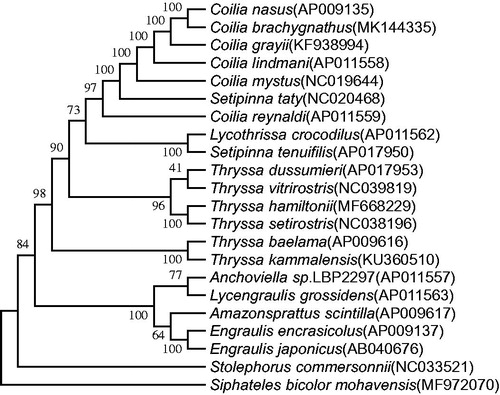Abstract
Coilia brachygnathus is the only one freshwater fish of the genus Coilia in China. In this study, we determined the complete mitochondrial genome of Coilia brachygnathus from Chaohu Lake. It is 16,896 bp in length and consists of 13 protein-coding genes, 2 rRNA genes, 22 transfer RNA genes as well as a control region (CR). Over base composition of the mitogenome is A(31.2%), C(27.0%), T(26.3%), and G(15.5%), respectively. Phylogenetic analysis confirmed the evolutionary relatedness of C. brachygnathus to other fishes of genus Coilia and also revealed the phylogenetic relationship of this genus within Engraulidae at molecular levels.
Coilia brachygnathus (Clupeiformes: Engraulidae: Coilinae) is a small economic fish restricted to central and eastern China and the only freshwater fish in the genus Coilia (Whitehead et al. Citation1988). Its species validity and phylogeny have been controversial and large differences have been detected among the samples from different rivers or Lakes (Liu Citation1995; Munroe and Nizinski Citation1999; Tang et al. Citation2007; Xu et al. Citation2009; Li et al., Citation2015). Therefore, it is very important to obtain the complete mitochondrial genome of C. brachygnathus from Chaohu Lake which is the 5th largest freshwater lake in China. Our results will facilitate further studies on Coilia fishes, including the phylogenetic relationship of the genus and population structure of C. brachygnathus.
In the paper, the specimen of C. brachygnathus was collected in Chaohu Lake (31°28′48″N, 117°33′36″E) and is stored in Fisheries Institute of Anhui Academy of Agriculture Sciences. The complete mitochondrial genome (mitogenome) was determined to be 16,896 bp in length (GenBank accession number MK144335). It is composed of the typical vertebrate mitochondrial features, including 13 protein-coding genes, 2 rRNA genes, 22 tRNA genes as well as a control region (CR). Eight tRNA and one protein-coding gene (ND6) are encoded on the light strand and all other genes are encoded on the heavy strand in all mitochondrial genes. Over base composition of the mitogenome is A (31.2%), C(27.0%), T(26.3%) and G(15.5%), respectively. Obviously, G content is the lowest and the content of A + T is higher than that of G + C.
Phylogenetic analysis was performed in MEGA 6 based on the complete mitogenomes (GenBank accession NO. behind species names) of selected 21 species of Engraulidae with Siphateles bicolor mohavensis as an outgroup (Tamura et al. Citation2013). The Maximum-Parsimony tree () confirmed the evolutionary relatedness of C. brachygnathus to other fishes of genus Coilia and also revealed the phylogenetic relationship of this genus within Engraulidae at molecular levels.
Acknowledgements
We are grateful to Dr. Yangyang Liang for the sample collection.
Disclosure statement
No potential conflict of interest was reported by the authors.
Additional information
Funding
References
- Liu WB. 1995. Biochemical and morphological comparison and interspecific relationships of four species of the genus Coilia in China. Oceanol LimnolSin. 26:558–565.
- Li XQ, An L, Wang YN, Ke H, Gao YF, Liu C. 2015. Morphological discriminant analysis and phylogeography of Coilia Ectenes Taihuensis in Nansi Lake on the eastern route of the south-to-north water transfer project. J Hydroecology 36:81–87.
- Munroe TA. Nizinski 1999. The living marine resources of the WCP Vol. 3 Batoid fishes, chimaeras and bony fishes part 1 (Elopidae to Linophrynidae). In: Carpenter KE, Niem VH, editors. FAO species identification guide for fishery purposes. Rome Engraulidae Anchovies: FAO; p. 1698–1706.
- Tamura K, Stecher G, Peterson D, Filipski A, Kumar S. 2013. MEGA6: molecular evolutionary genetics analysis version 6.0. Mol Biol Evol. 30:2725–2729.
- Tang WQ, Hu XL, Yang JQ. 2007. Species validities of Coilia brachygnathus and C. nasus taihuensis based on sequence variations of complete mtDNA control region. Biodivers Sci. 15:224–231.
- Xu ZQ, Ge JC, Huang C, Dou HX, Pan JL, Xia AJ. 2009. Taxonomy of short jaw tapertail anchovy Coilia brachygnathus by jaw length and mitochondrial Cytochrome b gene analysis. J Dalian Fish Univ. 24:242–246.
- Whitehead PJP, Nelson GJ. Wongratana, T. 1988. FAO species catalogue. Clupeoid fishes of the world (Suborder Clupeoidei). Part 2: Engraulididae. FAO Fish Synop. 7:125305–125579.

